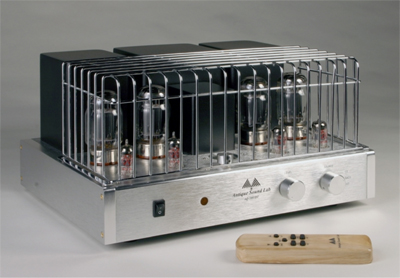You are reading the older HTML site
Positive Feedback ISSUE
17
january/february 2005
antique sound labs
AQ1001DT integrated
as reviewed by Jim Grudzien

|
JIM GRUDZIEN'S SYSTEM LOUDSPEAKERS ELECTRONICS SOURCE CABLES ACCESSORIES
|
I became aware of Antique Sound Lab's AQ1001DT integrated amplifier a couple of years ago, via the glowing PFO review in Issue 1, so I had very high expectations for the upgraded version. The new version uses higher quality parts, an extruded aluminum chassis, and employs choke filters for a faster, more dynamic sound. The transformers are also upgraded, for higher resolution. Like its predecessor, this amp puts out 50 watts per channel in pentode mode and 29 watts in triode. It has a built-in bias meter that is very easy to use, and a line level output for a subwoofer. Also new to this amp is a hand-carved wooden remote control and a tube cage. I preferred the looks without the cage.
The AQ1001DT's frequency response at 1W is 15Hz-23kHz, with distortion at 1%. Frequency response at full power is 32Hz-34kHz, with distortion at 3%. It has four inputs, very sturdy gold-plated five-way binding posts with both 4- and 8-ohm hookups, and weighs a substantial 48 pounds. It appears to be very well constructed.
I never used the stock cord, only my reference JPS AC+ cord, plus my Dali Silver Wave 4 speaker cables with Eichmann bananas. I used several sets of interconnects during the review, including Wasatch 105-U, DH Labs Revelation, and JPS Superconductor FX, but settled on the DH Labs. I switched between the pentode and triode modes before staying with the triode mode. The sound was warmer and sweeter, the way I believe tube amps should sound. Although the triode mode's 29 watts were sufficient for my Dali Grand speakers, the amp sounded less dynamic in this mode.
The AQ1001DT was dead quiet, with no annoying hissing to be heard from my speakers. It sounded warm, textured, smooth, and dimensional, and was a good match—although not a great match—for my soft, lush-sounding Dali Grands and Arcam CD player. It would probably sound awesome in a system that is slightly leaner than mine. The Margules that I reviewed earlier is in the same price range, but I would pick this amp every time. Although the Margules was more flexible, the ASL sounded better in my system.
The bottom end of the AQ1001DT was deep and full. Although it was not as tight as I'd have liked, it didn't lack weight. The midrange was wonderful—sweet, warm, emotional, musical, and engaging. The top end never offended with any of the nasties that some of my recordings can bring out. It was never harsh or bright, and remained true and accurate. Its imaging was solid, and the soundstage was as wide as my speaker placement, although when I played orchestral music, it sometimes seemed a little squeezed. I would have liked do a little tube rolling with this amp, as it brought the original amp to a whole new level of performance.
Stevie Ray Vaughan's version of "Tin Pan Alley,” from his Couldn't Stand the Weather CD, was terrific. The amplifier softened the hardness of SRV's guitar without losing much of its bite. His guitar work was more rounded and a little softer than it is with most solid-state amps. The bass had slightly less weight and solidity, and Stevie's voice had less growl and chestiness, but the soundstage was wide and three-dimensional, with good space between the instruments. This song was one of my favorites with this amp.
"Hotel California,” from the Eagles' Hell Freezes Over CD, is another favorite. I love the sound of acoustic guitar through a tube amp. Don Felder's opening guitar solo had that soft, rounded sound that is hard not to like. It had weight, but lacked the clear detail that this recording possesses. The presentation was enjoyable, but it was too soft to be lifelike. Don Henley's voice was relaxed and warm. The AQ1001DT didn't perform as well with rock music as it did with softer styles of music.
Israel Kamakawiwo'ole's "Somewhere Over the Rainbow,” from his Facing Future CD, was very musical. Iz' voice was rich, warm, and a little soft, more like Frank Sinatra's (i.e., less highly pitched) than it normally sounds. The ukulele sounded softer and more rounded than with the Edge gear I reviewed not too long ago, with an extended decay of each strum. Iz' ukulele playing got out of the way of his vocals, and the music just happened.
Hans Theesinks' Call Me CD was another disc that sounded way better than usual with this amp. His version of "Maybelline" had me hooked in the first twenty seconds. His breathy voice was very realistic and engaging. The twanginess of the guitar was softened, making it easier to engage with. The horns were full and somewhat soft, not harsh or excessively brassy. The AQ1001DT made this disc softer and more palpable, adding to an already enjoyable experience and making this disc another of my favorites.
There was a lot to like about this amp. It was very musical, engaging, textured, and emotional. It will fit the bill in a system that is on the lean side, although I found nothing offensive about it in my somewhat rich system. At $1495, I believe that it is a true bargain. I can recommend the AQ1001DT to anyone seeking to make the jump to tubes without spending a lot of money. Jim Grudzien
AQ1001DT
Retail: $1495/pair
Divergent Technologies
web address: www.divertech.com
